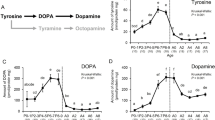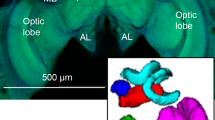Summary
The amount of neurosecretory material was measured in the brains of bees which had been used in a previous study (Vogel et al., 1977) for a determination of the rate of protein synthesis in the pars intercerebralis (PI).
The brains of bees trained to short feeding periods contain significantly lower amounts of neurosecretory material than those of bees flying the whole day. The amount of stored material appears to decrease as the reinforcement of training is extended. The daily changes in the storage of secretory material in the PI and corpora cardiaca (CC) show no direct correlation with flying activity, either in trained or in untrained bees.
Combining the data on protein synthesis with that on amounts of secretory material in the PI and CC, and taking into account the axonal flow conditions from the PI to the CC, the release of the Pi-material is estimated. These release curves correspond to the temporal activity pattern in all experimental groups.
Similar content being viewed by others
References
Cymborowski, B., Dutkowski, A.: Circadian changes in protein synthesis in the neurosecretory cells of the central nervous system ofAcheta domesticus. J. Insect Physiol.16, 341–348 (1970)
Cymborowski, B., Dutkowski, A.: Control of the circadian rhythm in the house cricket. J. Insect Physiol.19, 1423–1440 (1973)
Cymborowski, B., Flisińska-Bojanowska, A.: The effect of light on the locomotor activity and structure of neurosecretory cells of the brain and subesophageal ganglion ofPeriplaneta americana L. Zool. Polon.20, 387–402 (1970)
Eckert, M.: Immunologische Untersuchungen des neuroendokrinen Systems von Insekten. IV. Differenzierte immunhistochemische Darstellung von Neurosekreten des Gehirns und der Corpora cardiaca bei der SchabePeriplaneta americana. Zool. Jb. Physiol.81, 25–41 (1976)
Gabe, M.: Sur quelques applications de la coloration par la fuchsine-paraldéhyde. Bull. Micr. appl.3, 11–12, 153–162 (1953)
Gersch, M., Stürzebecher, J.: Weitere Untersuchungen zur Kennzeichnung des Aktivationshormones der Insektenhäutung. J. Insect Physiol.14, 87–96 (1968)
Girardie, J., Girardie, A., Moulins, M.: Étude Radiochimique après Électrostimulation de la Dynamique Fonctionelle des Cellules Neurosécrétrices Protocérébrales Médianes deLocusta migratoria. Gen. Comp. Endocrinol.30, 410–418 (1976)
Heinzeller, T.: Der intraneuronale Proteintransport im Gehirn vonApis mellifica L. als methodische Grundlage für eine histologische Untersuchung im Ocellarpedicellus. Diplomarbeit, Universität München (1970)
van Laere, O.: Ultrastructure of the corpora cardiaca in the honeybee. J. Apicult. Res.12, 81–98 (1973)
Michel, R.: Variations de la tendance au vol soutenu du criquet pélerinSchistocerca gregaria après implantations de corpora cardiaca. J. Insect Physiol.19, 1317–1325 (1973)
Normann, T.C.: Neurosecretory cells in insect brain and production of hypoglycaemic hormone. Nature254, 259–261 (1975)
Ochs, S.: Axoplasmic transport. In: Basic neurochemistry. Boston: Little, Brown and Comp. 1976
Sachs, L.: Angewandte Statistik, 4. Aufl. Berlin-Heidelberg-New York: Springer 1974
Stone, J.V., Cheeseman, P., Mordue, W.: Purification and characterisation of locust adipokinetic hormone. Gen. Comp. Endocrinol.29, 290–291 (1976)
Vogel, H., Heinzeller, T., Renner, M.: Daily protein synthesis in the pars intercerebralis and corpora allata ofApis mellifica L. with and without training to a foraging schedule. J. comp. Physiol.118, 51–60 (1977)
Weyer, F.: Über drüsenartige Nervenzellen im Gehirn der Honigbiene,Apis mellifica L. Zool. Anz.112, 137–141 (1935)
Author information
Authors and Affiliations
Additional information
We thank Dr. P. Schubert, Max-Planck-Institut für Psychiatrie Munich, for granting the use of his facilities (LEITZ-Classimat). We are very grateful to Mr. M. Sofroniew for critical review of the manuscript.
Rights and permissions
About this article
Cite this article
Heinzeller, T., Vogel, H. Daily release of neurosecretory material produced in the pars intercerebralis ofApis mellifica L. with and without training to a foraging schedule. J. Comp. Physiol. 126, 327–331 (1978). https://doi.org/10.1007/BF00667102
Accepted:
Issue Date:
DOI: https://doi.org/10.1007/BF00667102




